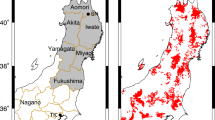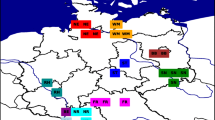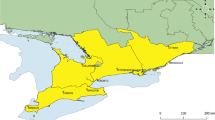Abstract
In the context of global warming, the general trend towards earlier flowering dates of many temperate tree species is likely to result in an increased risk of damage from exposure to frost. To test this hypothesis, a phenological model of apple flowering was applied to a temperature series from two locations in an important area for apple production in Europe (Trentino, Italy). Two simulated 50-year climatic projections (A2 and B2 of the Intergovernmental Panel on Climate Change - Special Report on Emission Scenarios) from the HadCM3 general circulation model were statistically downscaled to the two sites. Hourly temperature records over a 40-year period were used as the reference for past climate. In the phenological model, the heat requirement (degree hours) for flowering was parameterized using two approaches; static (constant over time) and dynamic (climate dependent). Parameterisation took into account the trees’ adaptation to changing temperatures based on either past instrumental records or the downscaled outputs from the climatic simulations. Flowering dates for the past 40 years and simulated flowering dates for the next 50 years were used in the model. A significant trend towards earlier flowering was clearly detected in the past. This negative trend was also apparent in the simulated data. However, the significance was less apparent when the “dynamic” setting for the degree hours requirement was used in the model. The number of frost episodes and flowering dates, on an annual basis, were graphed to assess the risk of spring frost. Risk analysis confirmed a lower risk of exposure to frost at present than in the past, and probably either constant or a slightly lower risk in future, especially given that physiological processes are expected to acclimate to higher temperatures.







Similar content being viewed by others
References
Aasa A, Jaagus J, Ahas R (2004) The influence of atmospheric circulation on plant phenological phases in Central and Eastern Europe. Int J Climatol 24:1551–1564
Ahas R, Aasa A (2006) The effects of climate change on the phenology of selected Estonian plant, bird and fish population. Int J Biometeorol 51(1):17–26. doi:10.1007/s00484-006-0041-z
Ashcroft LG, Richardson EA, Schuyler DS (1977) A statistical method of determining chill unit and growing degree hour requirements for deciduous fruit trees. HortScience 12(4):347–348
Avissar R, Mahrer Y (1988a) Mapping frost-sensitive areas with a three-dimensional local-scale numerical model. Part I: physical and numerical aspects. J Appl Meteorol 27:400–413 doi:10.1175/1520--0450(1988)027<0400:MFSAWA>2.0.CO;2
Avissar R, Mahrer Y (1988b) Mapping frost-sensitive areas with a three-dimensional local-scale numerical model. Part II: comparison with observations. J Appl Meteorol 27:414–426 doi:10.1175/1520--0450(1988)027<0414:MFSAWA>2.0.CO;2
Baldocchi D, Wong S (2008) Accumulated winter chill is decreasing in the fruit growing regions of California. Clim Change 87(Suppl 1):S153–S166. doi:10.1007/s10584-007-9367-8
Barbi A, Chiaudani A, Delillo I, Borin M, Berti A (2007) Andamenti agroclimatici nella regione Veneto nel periodo 1956 - 2004. Italian Journal of Agrometeorology, 12suppl. al n. 1 – 10° convegno nazionale di agrometeorologia (2007: 29–30 maggio, Isola di Capo Rizzuto (KR), 31 maggio, Lorica (CS). Quaderno degli abstracts:14–15
Barcaioli G, Crisci A, Zipoli G (2004) Costruzione di scenari climatici futuri ad alta risoluzione destinati allo studio del loro effetto sull’agricoltura italiana. In: "CLIMAGRI - Cambiamenti Climatici e agricoltura - Risultati attività II anno" UCEA, Roma giugno 2004 - ISBN 88-901472-1-0
Barker DH, Loveys BR, Egerton JJG, Gorton H, Williams WE, Ball MC (2005) CO2 enrichment predisposes foliage of a eucalypt to freezing injury and reduces spring growth. Plant Cell Environ 28(12):1506–1515. doi:10.1111/j.1365-3040.2005.01387.x
Barker T, Bashmakov I, Bernstein L, Bogner JE, Bosch P, Dave R, Davidson O, Fisher BS, Gupta S, Halsnaes K, Heij BJ, Kahn Ribeiro S, Kobayashi S, Levine MD, Martino DL, Masera O, Metz B, Meyer L, Nabuurs GJ, Najam A, Nakicenovic N, Rogner HH, Roy J, Sathaye J, Schock R, Shukla P, Sims REH, Smith P, Tirpak DA, Urge-Vorsatz D, Dadi Z (2007) Technical summary. In: Metz B, Davidson OR, Bosch PR, Dave R, Meyer LA (eds) Climate change 2007: Mitigation. Contribution of Working group III to the Fourth Assessment Report of the Intergovernmental Panel on Climate Change. Cambridge University Press, Cambridge
Bertrand A, Prevost D, Bigras FJ, Castonguay Y (2007) Elevated atmospheric CO2 and strain of rhizobium alter freezing tolerance and cold-induced molecular changes in alfalfa (Medicago sativa). Ann Bot (Lond) 99(2):275–284. doi:10.1093/aob/mcl254
Bindi M, Miglietta F, Gozzini B, Orlandini S, Seghi L (1997) A simple model for simulation of growth and development in grapevine (Vitis vinifera L.). I. Model description. Vitis 36(2):67–71
Brunetti A, Zinoni F (eds) (1999) Progetto Finalizzato PHENAGRI. Vol. 1 - Aspetti generali delle osservazioni agrofenologiche. Ministero delle Politiche Agricole e Forestali, Collana di Agrofenologia, Roma
Caffarra A, Chuine I, Donnelly A, Jones M (2005) Quantifying the environmental drivers of tree phenology. 17th International Congress on Biometeorology - ICB 2005, proceedings. Deutscher Wetterdienst, Annalen der Meteorologie 41, Vol. 2:493–497
Cannell MGR, Smith I (1986) Climatic Warming, Spring Budburst and frost damage on trees. J Appl Ecol 23:177–191. doi:10.2307/2403090
Chmielewski FM, Rötzer T (2001) Response of tree phenology to climate change across Europe. Agric Meteorol 108:101–112. doi:10.1016/S0168-1923(01)00233-7
Chmielewski FK, Müller A, Bruns E (2004) Climate changes and trends in phenology of fruit trees and field crops in Germany, 1961–2000. Agric For Meteorol 121:69–78. doi:10.1016/S0168-1923(03)00161-8
Chmielewski FK, Müller A, Kücher W (2005) Climate changes and frost hazard for fruit trees. 17th International Congress on Biometeorology - ICB 2005, proceedings. Deutscher Wetterdienst, Annalen der Meteorologie 41, Vol.2:488–491
Chuine I (2000) A unified model for budburst of trees. J Theor Biol 207:337–347. doi:10.1006/jtbi.2000.2178
Chuine I, Cour P, Rousseau DD (1998) Fitting models predicting dates of flowering of temperate-zone trees using simulated annealing. Plant Cell Environ 21:455–466. doi:10.1046/j.1365-3040.1998.00299.x
Chuine I, Cour P, Rousseau DD (1999) Selecting models to predict the timing of flowering of temperate trees: implications for tree phenology modelling. Plant Cell Environ 22:1–13. doi:10.1046/j.1365-3040.1999.00395.x
Cittadini ED, de Ridder N, Peri PL, van Keulen H (2006) A method for assessing frost damage risk in sweet cherry orchards of South Patagonia. Agric For Meteorol 141:235–243. doi:10.1016/j.agrformet.2006.10.011
Conover WJ (1999) Practical nonparametric statistics, 3rd edn. Wiley, New York
Črepinšek Z, Kaifež-Bogataj L, Bergant K (2006) Modelling of weather variability effect on fitophenology. Ecol Modell 194:256–265. doi:10.1016/j.ecolmodel.2005.10.020
Defila C, Clot B (2001) Phytophenological trends in Switzerland. Int J Biometeorol 45:203–207. doi:10.1007/s004840100101
De Lemos Filho JP, Villa Nova NA (1997) A model including photoperiod in degree days for estimating Hevea bud growth. Int J Biometeorol 41:1–4. doi:10.1007/s004840050045
Doi H, Katano I (2008) Phenological timings of leaf budburst with climate change in Japan. Agric For Meteorol 148:512–516. doi:10.1016/j.agrformet.2007.10.002
Donnelly A, Salamin N, Jones MB (2006) Changes in tree phenology: an indicator of spring warming in Ireland? BiolEnviron Proc R Ir Acad B 106(1):47–55
Eccel E, Toller G (1998) Annale meteorologico e climatologico della rete automatica “SPARTAC” - 1997. Ist Agr S Michele a/A (Trento, Italy)
Gu L, Hanson P, Mac Post W, Kaiser DP, Yang B, Nemani R, Pallardy S, Meyers T (2008) The 2007 Eastern US spring freeze: increased cold damage in a warming world? Bioscience 58(3):253–262. doi:10.1641/B580311
Guédon Y, Legave JM (2008) Analyzing the time-course variation of apple and pear tree dates of flowering stages in the global warming context. Ecol Modell 219:189–199. doi:10.1016/j.ecolmodel.2008.08.010
Hänninen H (1991) Does climatic warming increase the risk of frost damage in northern trees? Plant Cell Environ 14:449–454. doi:10.1111/j.1365-3040.1991.tb01514.x
Hänninen H (1995) Effects of climatic change on trees from cool and temperate regions and ecophysiological approach to modelling of bud burst phenology. Can J Bot 73:183–199. doi:10.1139/b95-022
Hänninen H, Kramer K (2007) A framework for modelling the annual cycle of trees in boreal and temperate regions. Silva Fenn 41(1):167–205
IPCC (2000) Special Report on Emission Scenarios, Nakicenovic N, Swart R (eds). Cambridge University Press, Cambridge
IPCC (2007a) Climate Change 2007. The Physical Science Basis. Solomon S, Qin D, Manning M, Chen Z, Marquis M, Averyt KB, Tignor M, Miller HL (eds). Contribution of Working Group I to the Fourth Assessment Report of the Intergovernmental Panel on Climate Change. Cambridge University Press, Cambridge
IPCC (2007b) Climate Change 2007: The Physical Science Basis. Summary for Policymakers. Contribution of Working Group I to the Fourth Assessment Report of the Intergovernmental Panel on Climate Change. ONU - IPCC, Geneva, Switzerland
Kramer K (1994) A modelling analysis of the effects of climatic warming on the probability of spring frost damage to tree species in The Netherlands and Germany. Plant Cell Environ 17:367–377. doi:10.1111/j.1365-3040.1994.tb00305.x
Kronenberg HG (1983) Relationships between temperatures and blooming dates of apple trees. Neth J Agric Sci 31:259–267
Landsberg JJ (1974) Apple fruit bud development and growth; analysis and an empirical model. Ann Bot (Lond) 38:1013–1023
Laughlin GP, Kalma JD (1987) Frost hazard assessment from local weather and terrain data. Agr For Metab 40:1–16. doi:10.1016/0168-1923(87)90050-5
Lutze JL, Roden JS, Holly CJ, Wolfe J, Egerton JJG, Ball MC (1998) Elevated atmospheric CO2 promotes frost damage in evergreen tree seedlings. Plant Cell Environ 21(6):631–635. doi:10.1046/j.1365-3040.1998.00296.x
Maugeri M, Brunetti M, Buffoni L, Lentini G, Mangianti F, Monti F, Nanni T, Pastorelli R (2006) Variabilità e cambiamenti climatici in Italia nel corso degli ultimi due secoli documentati da serie storiche secolari omogeneizzate. In: Esposito S, Epifani C, Serra CP (eds) CLIMAGRI - Cambiamenti climatici e agricoltura. Risultati conclusivi. Roma, ottobre 2006. pp 15–29
Meehl GA, Stocker TF, Collins WD, Friedlingstein P, Gaye AT, Gregory JM, Kitoh A, Knutti R, Murphy JM, Noda A, Raper SCB, Watterson IG, Weaver AJ, Zhao Z (2007) Global Climate Projections. In: Solomon S, Qin D, Manning M, Chen Z, Marquis M, Averyt KB, Tignor M, Miller HL (eds) Climate Change 2007: The Physical Science Basis. Contribution of Working Group I to the Fourth Assessment Report of the Intergovernmental Panel on Climate Change. Cambridge University Press, Cambridge
Menzel A (2002) Phenology: its importance to the global change community. An editorial comment. Clim Change 54:379–385. doi:10.1023/A:1016125215496
Menzel A (2003) Plant phenological anomalies in Germany and their relation to air temperature and NAO. Clim Change 57:243–263. doi:10.1023/A:1022880418362
Menzel A, Sparks TH, Estrella N (2006) European phenological response to climate change matches the warming pattern. Glob Change Biol 12:1969–1976. doi:10.1111/j.1365-2486.2006.01193.x
Murray MB, Cannell MGR, Smith RI (1989) Date of budburst of fifteen tree species in Britain following climatic warming. J Appl Ecol 26:693–700. doi:10.2307/2404093
Murphy JM (1999) An evaluation of statistical and dynamical techniques for downscaling local climate. J Clim 12:2256–2284 doi:10.1175/1520--0442(1999)012<2256:AEOSAD>2.0.CO;2
Murphy JM (2000) Predictions of climate change over Europe using statistical and dynamical downscaling techniques. Int J Climatol 20:489–501 doi:10.1002/(SICI)1097-0088(200004)20:5<489::AID-JOC484>3.0.CO;2-6
Osborne CP, Chuine I, Viner D, Woodward FI (2000) Olive phenology as a sensitive indicator of future climatic warming in the Mediterranean. Plant Cell Environ 23:701–710. doi:10.1046/j.1365-3040.2000.00584.x
Pantezzi T, Pellegrini F (2008) La difesa dalle gelate primaverili su melo in Trentino. Ital J Agrometeorol (in press).
Pope V, Gallani ML, Rowntree PR, Stratton RA (2000) The impact of new physical parameterizations in the Hadley Centre climate model: HadAM3. Clim Dyn 16:123–146. doi:10.1007/s003820050009
Pratizzoli W, Zinoni F, Eccel E (2008) Metodi di irrigazione antibrina tradizionali e innovativi a confronto. Le esperienze in Trentino e in Emilia. Ital J Agrometeorol (in press).
Rahimi M, Hajjam S, Khalili A, Kamali GA, Stigter CJ (2007) Risk analysis of first and last frost occurrences in the Central Alborz Region, Iran. Int J Climatol 27(3):349–356. doi:10.1002/joc.1405
Rea R, Eccel E (2006) Phenological models for blooming of apple in a mountainous region. Int J Biometeorol 51(1):1–16. doi:10.1007/s00484-006-0043-x
Repo T, Hanninen H, Kellomaki S (1996) The effects of long-term elevation of air temperature and CO2 on the frost hardiness of Scots pine. Plant Cell Environ 19(2):209–216. doi:10.1111/j.1365-3040.1996.tb00242.x
Richardson EA, Seeley SD, Walker DR (1974) A model for estimating the completion of rest for “Redhaven” and “Elberta” peach trees. HortScience 9:331–332
Richardson EA, Ashcroft GL, Anderson JL, Seeley SD, Walker DR, Alfaro JF, Griffin RE, Keller J (1975) Pheno-climatography of selected fruit trees as used in programming sprinkling for bloom delay. Paper No. 75-4053, American Society of Agricultural Engineers, Davis, California, June 22-25
Rochette P, Belanger G, Castonguay Y, Bootsma A, Mongrain D (2004) Climate change and winter damage to fruit trees in eastern Canada. Can J Plant Sci 84:1113–1125
Rutishauser T, Luterbacher J, Jeanneret F, Pfister C, Wanner H (2007) A phenology-based reconstruction of interannual changes in past spring seasons. J Geophys Res - Geobiosci 112:G04016. doi:10.1029/2006JG000382
Rutishauser T, Luterbacher J, Defila C, Frank D, Wanner H (2008) Swiss spring plant phenology 2007: extremes, a multi-century perspective, and changes in temperature sensitivity. Geophys Res Lett 35:L05703. doi:10.1029/2007GL032545
Schär C, Vidale PL, Lüthi D, Frei C, Häberli C, Liniger LA, Appenzeller C (2004) The role of increasing temperature variability in European summer heat waves. Nature 427:332–336. doi:10.1038/nature02300
Scheifinger H, Menzel A, Koch E, Peter C, Ahas R (2002) Atmospheric mechanisms governing the spatial and temporal variability of phenological phases in central Europe. Int J Climatol 22:1739–1755. doi:10.1002/joc.817
Schwartz MD, Ahas R, Aasa A (2006) Onset of spring starting earlier across the Northern Hemisphere. Glob Change Biol 12:343–351. doi:10.1111/j.1365-2486.2005.01097.x
Snelgar WP, Hall AJ, Mcpherson HG (2008) Modelling flower production from winter chilling. N Z J Crop Hortic Sci 36:273–284
Snyder RL, de Melo-Abreu JP (2005) Frost Protection: fundamentals, practice and economics, Vol. 1. Environmental and Natural Resouces Series, FAO, Rome
Tait A, Zheng X (2003) Mapping frost occurrence using satellite data. J Appl Meteorol 42(2):193–203
Tryjanowski P, Panek M, Sparks T (2006) Phenological response of plants to temperature varies at the same latitude: case study of dog violet and horse chestnut in England and Poland. Clim Res 32(1):89–93
Winter F (1986) A simulation model of phenology and corresponding frost resistance of “Golden Delicious” Apple. Acta Hortic 184:103–108
Zinoni F (2008) The problem of agricultural frosts in the world and in Italy. Ital J Agrometeorol (in press)
Zinoni F, Antolini G (2002) The effect of climate modifications on the risks of freezing (winter, precocious, late) and on the cold requirements of cultivated-species. Proceedings of First Technical Workshop of the Mediterranean component of CLIMAGRI project on Climate Change and Agriculture, FAO, Rome 25-27 September
Zinoni F, Antolini G, Marletto V (2004) Valutazione del rischio da gelata tardiva. In: Anconelli et al. (eds), Previsione e difesa dalla gelate tardive. ARPA Emilia - Romagna, Notiziario tecnico, pp 29–48
Acknowledgments
The present work has been carried out in the frame of the research project “GEPRI”, funded by “Fondo Unico per la Ricerca” of the Autonomous Province of Trento administration. We thank for their collaboration: Tommaso Pantezzi, Claudio Dalsant, Stefano Corradini, Piero Cau (FEM), Marianna Nardino and Osvaldo Facini (CNR - IBIMET), Federico Spanna (Regione Piemonte).
Author information
Authors and Affiliations
Corresponding author
Additional information
An erratum to this article can be found at http://dx.doi.org/10.1007/s00484-009-0235-2
Rights and permissions
About this article
Cite this article
Eccel, E., Rea, R., Caffarra, A. et al. Risk of spring frost to apple production under future climate scenarios: the role of phenological acclimation. Int J Biometeorol 53, 273–286 (2009). https://doi.org/10.1007/s00484-009-0213-8
Received:
Revised:
Accepted:
Published:
Issue Date:
DOI: https://doi.org/10.1007/s00484-009-0213-8




